Understanding about Cataract surgery
If one has a cataract, that not always mean that they require surgery. One may not even see any change in their viewing power. Some individuals who have this condition can view everything just fine if they wear prescript glasses.
But as cataracts increase, they can cause more symptoms. However, as the disease grows, or if the central vision gets worse, the only choice for its control is surgery. The effects are blurred vision, glare, and sensitivity to bright lights. When the disease grows, it seems to be painless. Following a decrease in vision which can also appear in a weak quality of life that is in day-to-day activities like driving and working.
This happens usually in elder people of age 50 but nowadays it can be seen in infants and young children too. Its a safe and secure procedure and after the completion of the procedure one is able to see better than before.
Cataract surgery by eyemantra in Delhi involves absorbing out the natural lens after change state inside the eye by a method known as phacoemulsification. After this, an artificial intraocular lens called IOL is placed in its place which returns natural and normal vision
The cataract surgery procedure is conducted under local anaesthesia injected around the eye or topical anaesthesia numbing drops injected into the eye.
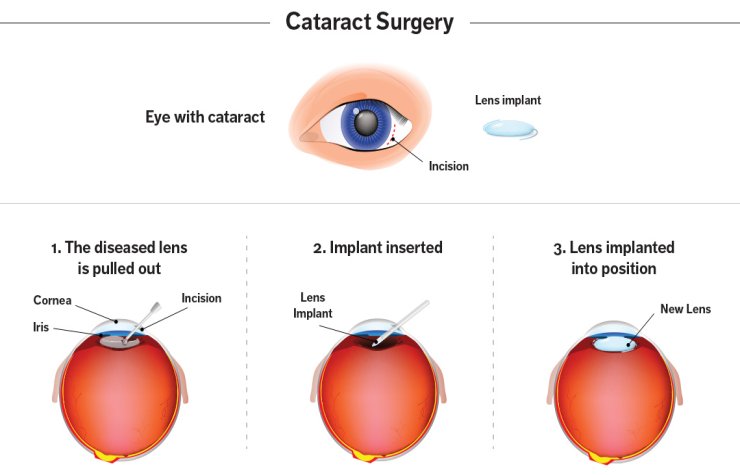
Cataracts Surgery Basics
- In cataract surgery, the lens inside your eye that has become cloudy is eliminated and substituted with an artificial lens called an intraocular lens( IOL) to return clear vision.
- Multiple advanced cataract procedures include the usage of a high-frequency ultrasound device. That can further break up the cloudy lens into tiny pieces, which are then kindly removed from the eye with suction.
- The system typically is conducted on an outpatient basis and does not need an overnight stay in a hospital or other care facility.
- After all remains of the cloudy lens have been removed from your eye, the cataract surgeon injects a clear intraocular lens, placing it safely behind the iris and pupil, in the same location your natural lens occupied. In exceptional cases, an IOL might be located in front of the iris and pupil, but this is less obvious.
- The surgeon then finishes the cataract removal and IOL implantation procedure by closing the incision in your eye. A stitch may or may not be required. Also, a protective shield is put over the eye to keep it protected in the early stages of your cataract surgery recovery.
Types of cataracts
All of these are cataracts which can be founded in the elderly or kids
- Nuclear Cataracts
- Cortical Cataracts
- Posterior Subcapsular Cataracts
- Anterior Subcapsular Cataracts
- Congenital Cataracts
- Traumatic Cataracts
- Secondary Cataracts
- Radiation Cataracts
- Lamellar or Zonular Cataracts
- Posterior Polar Cataracts
- Anterior Polar Cataracts
- Post-Vitrectomy Cataracts
Out of all of the above, there are the most common cataracts are founded.
Nuclear Sclerotic Cataracts
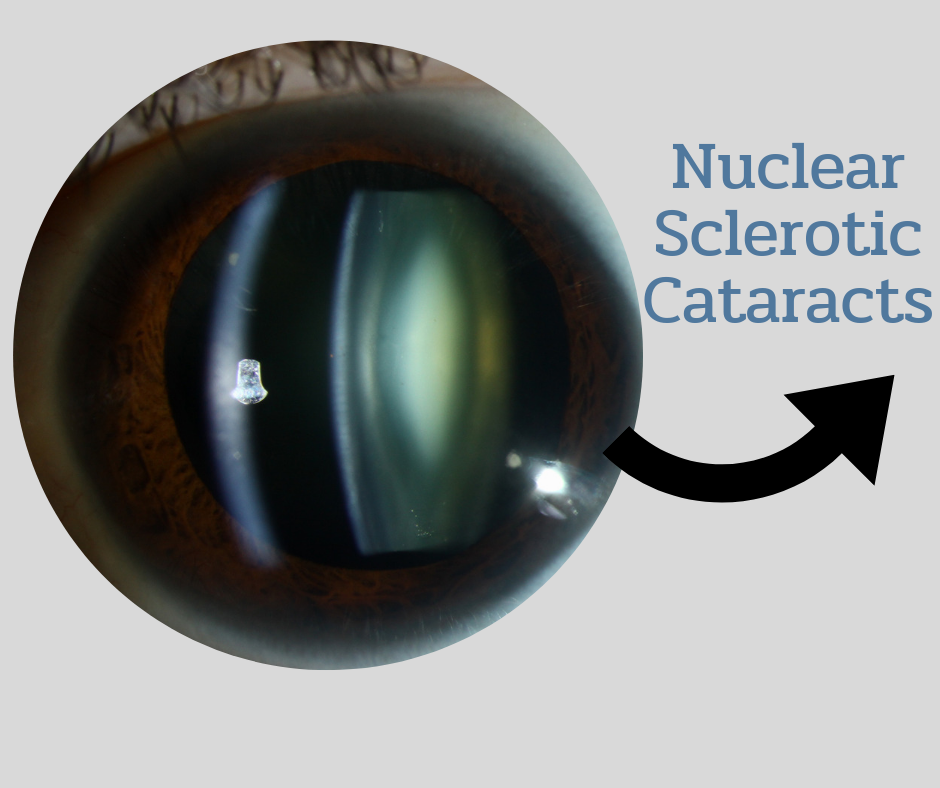
A nuclear cataract is the most basic type of cataract. Starting with a slow hardening and yellowing of the middle part of the lens also recognised as the nucleus. Over time, this hardening and yellowing will increase to the extra layers of the lens.
This type of cataract grows that switches the eye’s strength to focus and close-up vision (for reading or another kind of close work) may temporarily develop. This symptom is indicated to second sight, but the vision develops.
A nuclear sclerotic cataract grows slowly and can take many years for progressive development before it starts to affecting vision.
Cortical Cataracts
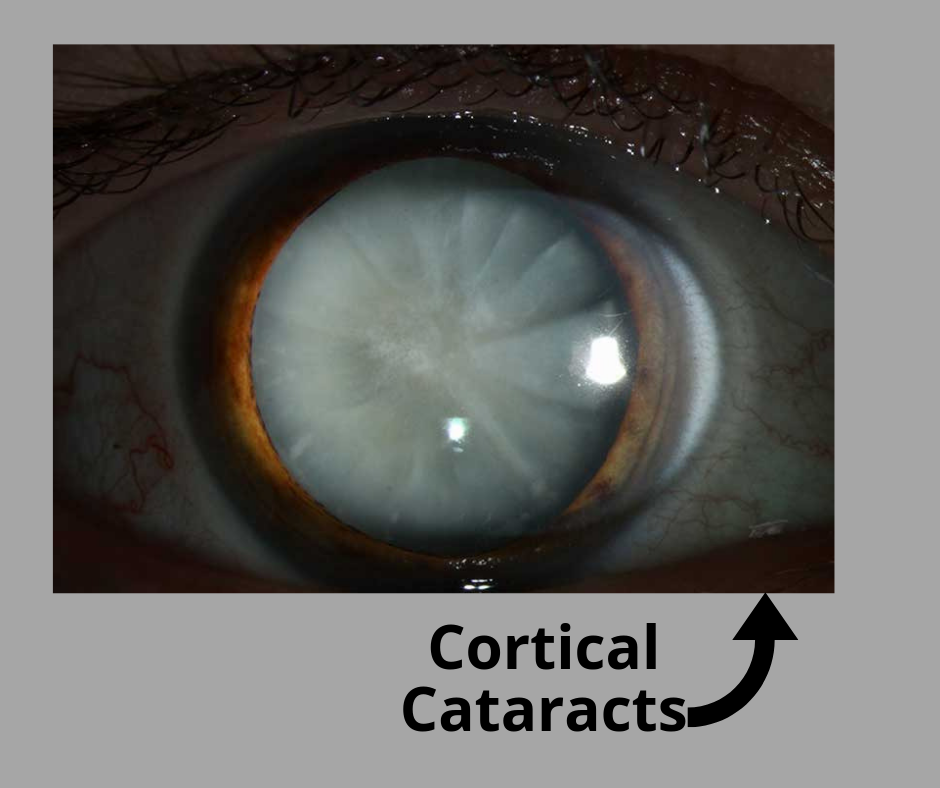
A cortical cataract forms in the shell layer of the lens identified as the cortex and slowly increases its “spokes” from the exterior of the lens to the centre. These gaps can cause the light that enters the eye to scatter, building difficulties with blurred vision, glare, contrast and depth perception. People with diabetes are at risk of evolving cortical cataracts.
Posterior Subcapsular Cataracts
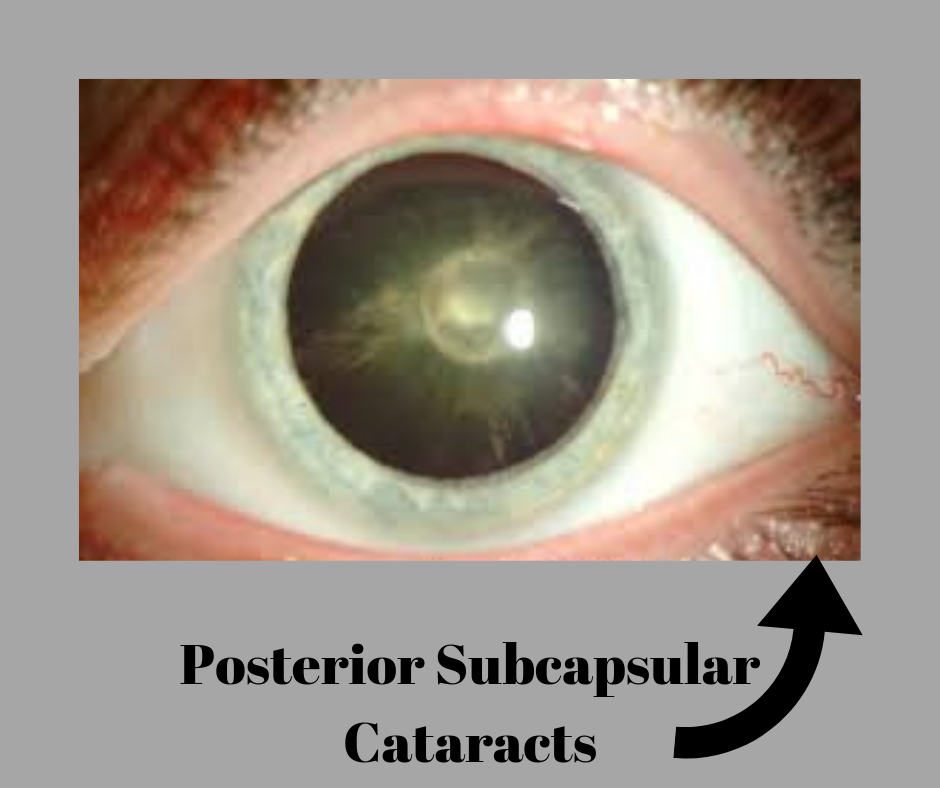
This type of cataract starts with affecting one’s reading and night vision. A small opaque or cloudy area on the back surface of the lens is called subcapsular. This happens because it forms below the lens capsule which is a small sac or membrane that encircles the lens and retains it in position.
Who will face this problem in future?
- A person who have age more than 60 years
- People with prolonged use of steroids
- Overexposure to ultraviolet rays
- People suffering from Diabetes
- Injuries related to eye
Why One should go for cataracts Surgery?
Reasons why a person needs cataract surgery are :
- One may be facing a dim, blurred, or yellow vision or may also possess double vision when you look at things through the eye with the cataract. These difficulties can make it tough to read, work on a computer, and do anything else that asks for clear eyesight. This is why we one needs cataracts surgery.
- One may have poor night vision and discover it more difficult to drive when it’s dark. Persons with advanced cataracts can even fail the eyesight part of a driver’s test.
- Cataracts can make a person more sensitive to glare from the sun. One may see a halo nearby bright lights. It also makes it more difficult to play a few sports, like golf.
If one has any of these symptoms, surgery can help.
Sometimes one may require to get surgery even if your cataract doesn’t trouble you. Your doctor may recommend it if the cataract makes it difficult for one to make a clear picture of the back of their eye while an eye exam.
Eligibility criteria for cataracts surgery
One is an eligible candidate for cataract surgery if you are :
- Undergoing cloudy vision
- Observing bright colours as faded
- Experiencing double visions
- Feeling light sensitivity
- Undergoing poor night vision
- No Pregnancy and nursing
- Cataracts are hindering your daily activities such as driving, reading, cooking, or your outdoor activities
- Not undergoing dry eyes activity
How will one get to know that they need cataracts surgery?
After a precise and complete eye evaluation, doctors will discuss the diagnosis of cataract and your best-corrected visual acuity (your vision with glasses). They will help you to decide for yourself, with test lenses, if you are satisfied with this vision by wearing glasses in your day to day life or not.
In case, if you are not satisfied, in the absence of any eye disease that may harm your vision, the surgeon will talk with you the chance of cataract surgery in Delhi, and its convenient procedure.
How one can prepare for cataracts surgery?
To prepare for cataract surgery, one may be directed to:
- Undergo various tests- A week or so before your surgery, your doctor conducts a painless ultrasound test to estimate the size and shape of your eye. This helps to restrict the best type of lens implant (intraocular lens, or IOL).
- Stop using specific medications- Your doctor may recommend you to briefly stop taking any medication that could raise your risk of bleeding throughout the procedure. Let your doctor know if you take any medications for prostate difficulties, as some of these drugs can interfere with cataract surgery.
- Use eye drops to decrease infection risk-Antibiotic eyedrops may be suggested to use for 1-2 days before surgery.
- No Food -You may be directed not to eat or drink anything 12 hours before the cataract procedure.
- Plan for your recovery- Usually, you can go home on the day as your surgery gets completed. But you won’t be able to do any outdoor activities.
Types of cataracts surgery
Phacoemulsification (phaco)
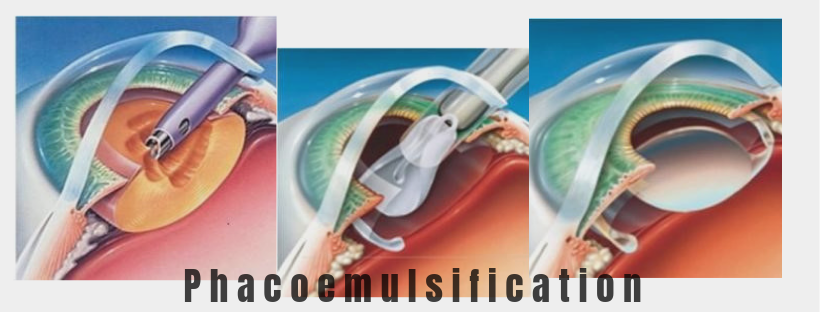
Phacoemulsification is a new cataract surgery in which the eye’s internal lens is fuse with an ultrasonic handpiece and aspirated from the eye. Aspirated fluids are substituted with irrigation of balanced salt solution to support the anterior chamber.
During phaco surgery, a surgeon makes a tiny incision at the tip of the cornea and then performs an opening in the membrane that encloses the lens. A little ultrasonic probe is then inserted, breaking up the cloudy lens into small fragments. The instrument vibrates at ultrasonic speed to cut and nearly dissolve the lens material into little fragments. The fragments are then suctioned out of the capsule by an attachment on the probe tip.
After the lens particles are eliminated, an intraocular lens implant, generally referred to as an IOL, is implanted and placed into the lenses natural capsule. It is injected through the tiny corneal incision by a hollowed-out tube. Once the lens is forced by, it opens and is positioned in place.
Femtosecond Cataracts Surgery
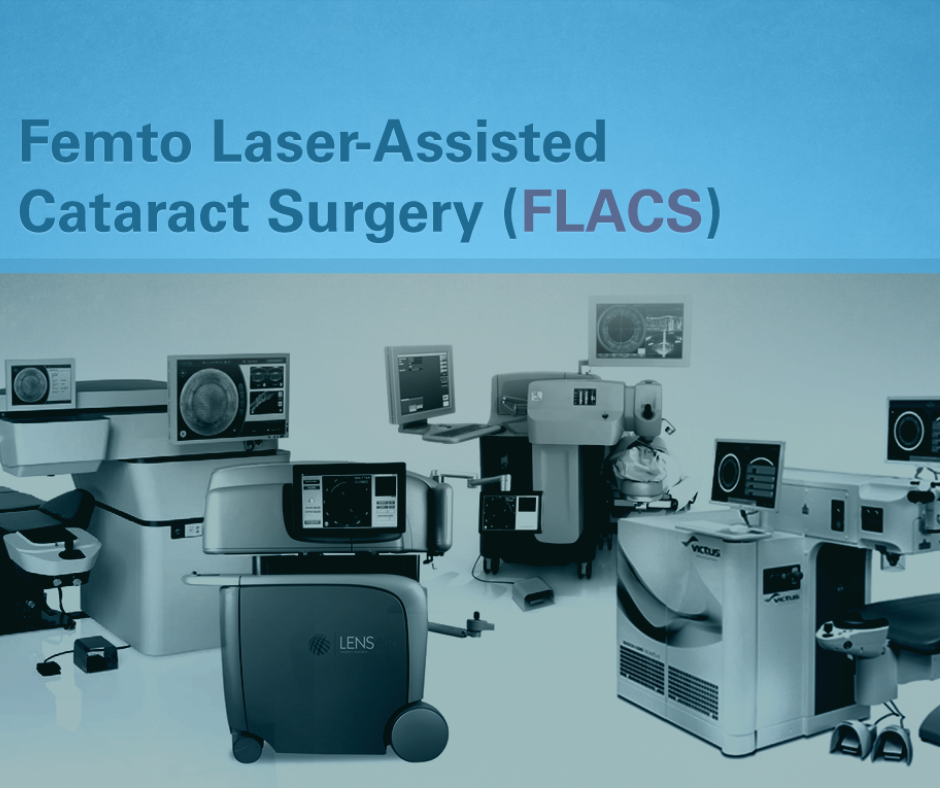
Femtosecond surgery is a different option possible for your doctor to use as cataract surgery. It is an FDA approved, a computer-guided laser that is processed by the surgeon. This device can help the surgeon in the performance of some of the steps included in the elimination of a cataract. It can also be used in procedures conducted to correct astigmatism.
Zepto cataracts or Zepto Capsulotomy Device for Cataract Surgery
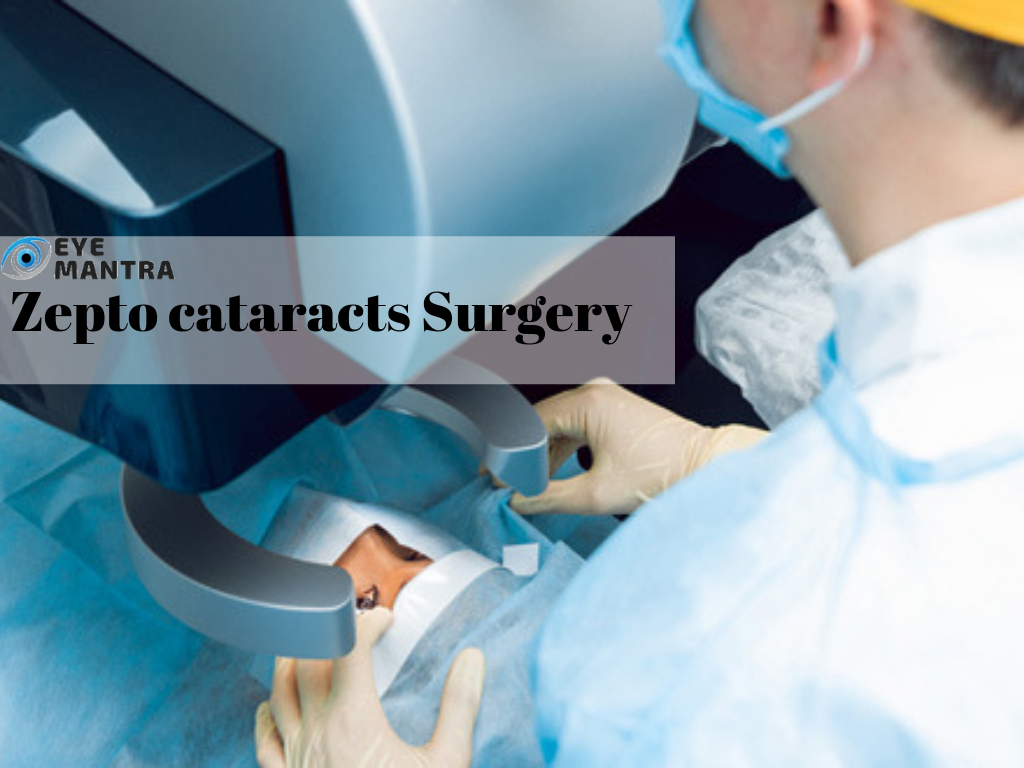
Zepto Capsulotomy Device for cataract surgery” is significantly lower than femtosecond cataract surgery, and practices a handheld disposable device to create a particular and precise capsulotomy. This seems in some logistical challenges and decreases overall surgical time in comparison to Femtosecond laser-assisted cataract surgery. Plus, Femtosecond laser cannot be practised in patients with corneal opacities or small pupils, while the Zepto capsulotomy device can be. The device also offers the surgery more reliable and more anticipated.
Manual small incision cataract surgery (MSICS)

This technique is an unfolding of ECCE where the whole lens is sent out of the eye by a self-sealing scleral tunnel wound. A properly formed scleral tunnel is watertight and does not need suturing. The “small” in the title indicates to the wound being comparatively smaller than an ECCE, although it is still considerably larger than a phaco wound. Head-to-head trials of MSICS vs phaco in dense cataracts have seen no variation in results, but lower performing time and significantly lower costs with MSICS.
Extracapsular cataract extraction (ECCE)
Extracapsular cataract extraction includes the removal of almost the whole natural lens. While the elastic lens capsule that is posterior capsule is left unimpaired to enable implantation of an intraocular lens. It involves the manual expression of the lens by a large incision created in the cornea or sclera. Its is usually 10–12 mm.
Although it requires a larger incision and the use of stitches, the traditional method may be designated for patients with very hard cataracts or other situations in which phacoemulsification is questionable.
Intracapsular cataract extraction (ICCE)
It involves the removal of the lens and the enclosing lens capsule in one section. The procedure has a comparatively high rate of difficulties due to the large incision required and pressure placed on the vitreous body. It has consequently been largely replaced and is usually done in countries where working microscopes and advanced-technology equipment are easily accessible. After lens removal, an artificial plastic lens an intraocular lens implant can be set in either the anterior chamber or sutured into the sulcus.
Side Effects of cataracts surgery
Side effects are limited from cataract surgery, but few things that can occur.
- Swelling or Eye infection
- The feeling of pressure into your eye
- Bleeding
- Detachment of Retinal
- Loosening of the latest implant
- Fluid accretion in your eye
- Drooping of eyelid
Cataract Surgery Costs
Cataract surgery expenses are usually covered by Medicare if you are Medicare available. Private insurance usually includes cataract surgery as well. The cost of cataract surgery depends upon the age of the person, the intraocular lens was taken also the earlier history of eye procedures. Depending upon these parts, cataract surgery cost can vary from Rs to Rs. The specific price can be decided by visiting our clinic eye mantra. Also, get engage with our cataract surgeons in Delhi who will discover the precise condition of the eyes and can provide you with an exact cost calculation.
What you can expect
Pre- preparation for cataract surgery
Almost everyone who has cataract surgery will be given an artificial lens IOL. These lenses improve your vision by concentrating light on the back of your eye. You won’t be able to view or sense the lens. It needs no care and stays a permanent part of your eye. A variation of IOLs with various features are available. Before surgery, you and your eye doctor will explain which type of IOL can work best for you and your healthy life. Cost may also be a part, as insurance companies may not compensate for all types of lenses.
IOLs
- IOLs are made of plastic, acrylic or silicone.
- Many of the IOLs block ultraviolet light.
- Some IOLs are rigid plastic and implanted by an incision that needs several stitches (sutures) to close.
- Many IOLs are adjustable, providing a shorter incision that needs few or no stitches.
The surgeon gives this type of lens and injects it into the empty capsule where the natural lens applied to be. Once inside the eye, the collapsed IOL unfolds, filling the empty capsule.
Many types of lenses easily available can be seen as :
- Fixed-focus mono-focal
This type of lens has a particular focus power for distance vision. Reading will usually need the wear of reading glasses.
- Accommodating-focus mono-focal
Although these lenses must have a particular focusing power, they can react to eye muscle movements and change focus on to near or far objects.
- Multifocal
These lenses are related to glasses with bifocal or progressive lenses. Several areas of the lens have various focusing powers, providing near, medium and distant vision.
- Astigmatism correction (toric).
If you have particular astigmatism, a toric lens can assist in correcting your vision.
Share the advantages and risks factors of the various kind of IOL with your eye surgeon to know what’s good for you.
During cataract surgery
Cataract surgery, normally an outpatient procedure, takes 1 hour or less to be conducted.
- First, your doctor will put eye drops in your eye to increase your pupil. You’ll receive local anaesthetics to anaesthetize the area. Then you may be provided with a medication that helps you to relax. If you’re provided with a sedative it will make you remain awake but tired during surgery.
- During cataract surgery, the clouded lens is eliminated. A clear artificial lens is normally implanted. In some cases, a cataract may be eliminated without implanting an artificial lens. with different surgical methods.
Surgical methods used to eliminate cataracts include:
- Applying an ultrasound probe to break up the lens for removal. During a procedure called phacoemulsification, your surgeon creates a tiny incision in the front of your eye that is cornea. Further inserts a needle-thin probe into the lens element where the cataract has developed. Your surgeon then uses the probe, which sends ultrasound waves, to break up the cataract and suction out the fragments. The very back of your lens the lens capsule is left unimpaired to help as a place for the artificial lens to rest. Stitches may or may not be applied to join the tiny incision in your cornea after the procedure.
- Using high-level laser technology to eliminate the cloudy lens. In laser-assisted cataract surgery, the surgeon uses a laser to perform all incisions and soften the cataract for elimination.
- Creating an incision in the eye and eliminating the lens in one piece. A less commonly used method called extracapsular cataract extraction. This needs a longer incision than that used for phacoemulsification. By this larger incision, your surgeon applies surgical tools to eliminate the front capsule of the lens and the cloudy portion of your lens holding the cataract. This procedure may be done if you have certain eye complexities.
Once the cataract has been eliminated by phacoemulsification or extracapsular extraction, the artificial lens is implanted into the empty lens capsule.
After cataract surgery
- After cataract surgery, expectations are a vision to begin improving within some days. Your vision may be blurry at once but after that, it begins eye with healing and improves.
- Colours may appear brighter after surgery because you are seeing through a new and clear lens.
- Keep visiting your eye doctor in a day or two after your surgery, the following week, and then repeat after about a month to observe healing.
- It’s common to sense itching and moderate discomfort for a couple of days after surgery. Avoid rubbing or straining on your eye.
- Visit your doctor just after you experience any of the following:
- Loss of vision
- Pain that continues despite the taking a course of medicines
- Raised eye redness
- Light flashes or many new spots (floaters) in front of your eye
Many people require glasses for some of the time just after cataract surgery.
If you have cataracts in both eyes, your doctor normally schedules the 2nd surgery after the first eye has healed.
Results of the surgery
Cataract surgery strongly recovers vision in the majority of a person who has gone through the procedure.
People who had cataract surgery may get a secondary cataract. In the medical terms, this complexity is named as posterior capsule opacification (PCO). This occurs when the back of the lens capsule that is the part of the lens that wasn’t eliminated during surgery and that presently supports the lens implant that becomes cloudy and impairs your vision.
PCO is operated with a painless 5 minutes outpatient method called YAG that is yttrium-aluminium-garnet the laser capsulotomy. In YAG laser capsulotomy, is a laser beam is applied to make a little opening in the clouded capsule to give a clear path by the way light can pass.
After the procedure, stay in the doctor’s office to make sure your eye stress doesn’t rise. Other difficulties are rare but can involve raised eye pressure and retinal detachment.
Cataract Surgery Recovery
- Time after surgery the days of the week’s situation.
- You will have to apply eye drops after surgery. Make sure to comprehend your doctor’s medicinal courses for using these drops.
- Avoid using soap or water directly in the eye.
- Do not rub or press on your eye. Your ophthalmologist may suggest you wear eyeglasses or some other shield to protect your eye.
- One will be asked to wear a protective eye shield while sleeping.
- Your ophthalmologist will talk with regarding how active you can be soon after surgery. He or she will tell you when you can reliably exercise, drive or do different activities again.
Laser Cataract Surgery
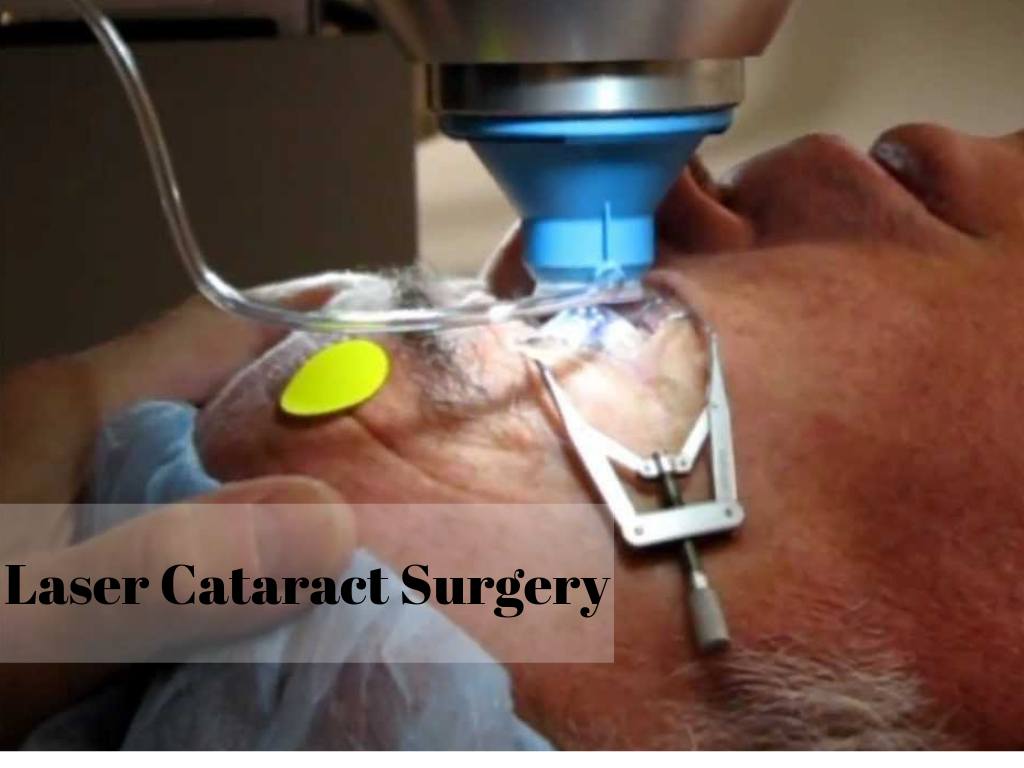
Recently, many femtosecond lasers similar to the lasers used to generate the corneal flap in all-laser LASIK — have been recognised by the FDA.
- These lasers have obtained approval for the following steps in cataract surgery, decreasing the demand for surgical blades and other hand-held tools:
- Producing corneal incisions to enable the surgeon access to the lens
- Separating the anterior capsule of the lens
- Fragmenting the cataract so less phaco energy is needed to break it up and eliminate it.
- Formulating peripheral corneal incisions to decrease astigmatism when required.
- Lasers can develop accuracy during several steps of cataract surgery, they may not significantly advance cataract surgery protection, recovery time and visual results in every case.
Frequently Asked questions
1) How much time will be taken to heal from cataract surgery?
Ans. It will take about 6 – 10 weeks to totally to heal from cataract surgery.
2) Is surgery the single method to operate cataracts?
Ans. Our optometrist can guide changes in your eyewear that will assist one to see more precisely until the surgery is required. When eyewear no longer gives adequate eyesight, surgery is the only recommended that means completely treating cataracts.
3) Is cataract surgery safe for thinking of future aspects?
Ans. Yes, the Cataract surgery is commonly recommended as its a permanent and never takes much time to get operated. Also, the healing time is quick and gives you a clear and new vision.
4) Is laser cataract surgery beneficial?
Ans. Yes, it is beneficial as :
- A deeply customized treatment using high-level 3D imaging
- An extra specific treatment
- Gentler and more comfortable cataract elimination with less ultrasound energy
- More choices for astigmatism correction
5) What is a do you mean by secondary cataract?
Ans. This secondary cataract also called posterior capsular opacification. Normally can be simply treated with a less invasive follow-up method called a YAG laser capsulotomy.
In this case, a just few months or years of cataract surgery, the posterior portion of the lens capsule that is in the left side inside the eye is facing problems. It happens during surgery for security reasons becomes hazy, creating a vision to repeatedly become blurred.
Conclusion
Cataracts have become nearly normal for people to be diagnosed after the age of 50 years. In this situation, clouding occurs in the natural lenses of the eyes, which lie back the iris and the pupil.
A cataract may happen as a result of prior eye surgery such as ICL. Also, because of ageing, genetic disease, diabetes, illness to ultraviolet rays or radiation, or eye injury which alters the tissue of the Laser Cataract Surgeryeye lens. When a cataract happens, the natural lens of the eyes become hazy due to protein denaturation. This blocks light from passing through the lens, clouding the vision.
Cataracts surgery is a recommended procedure that holds around 30 to 45 minutes.
For the newest information about laser cataract surgery, ask our eye doctor while your preoperative eye exam and cataract surgery consultation. Our other services include Neuro-Ophthalmology, Pediatric Ophthalmology, Squint Correction, and many more.
For reaching ou expertise one can drop an email on eyemantra1@gmail.com. Or visit our website Eyemantra.
For book, prior appointments or for any, call at +91-8851044355. Customer is our First Priority!
Realted Articles
